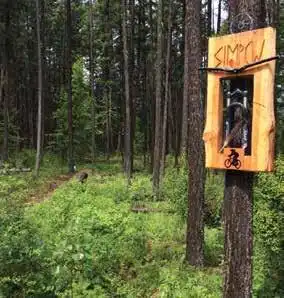
3 minute read
P31 McConnell Lake Day use C
WELLS GRAY-BACKCOUNTRY
Beyond the relatively accessible areas along the Clearwater River Corridor, at Murtle Lake, (access from Blue River off Highway 5 - 24 km of gravel Rd.) and at Mahood Lake, (Access is either via 76 km of paved and gravel roads along the south shore of Canim Lake on the Canim-Hendrix Lake rd. or via 57 km of gravel road from the interlakes corner on Highway 24) lie thousands of hectares of pristine wilderness that is Wells Gray Backcountry. This is a wilderness area largely untouched, though not unexplored by the more adventurous visitor, both past and present.
Advertisement
Hikers who venture into this area must have the skills required to navigate largely unmarked routes, and the equipment needed to survive without facilities. No fires are allowed in the backcountry, so cooking must be accomplished on small stoves carried in, and warm clothing must compensate for often colder temperatures at higher elevations. Hikers in the mountains should be prepared for extreme weather conditions that change without much warning.
At several locations, such as Fight Lake on Battle Mountain, camping areas have been designated, a pit toilet and bear cache installed. Campers must practice leave-no-trace camping when in the backcountry. This includes the careful disposal of human wastes, and the carrying out of all garbage. Animals such as mountain caribou, moose, black and grizzly bear, even mountain goat, are often sighted by backpackers into the wilderness of Wells Gray. Precautions must always be taken to avoid encounters with these large animals.
The opportunities for hiking untouched wilderness, climbing glacier clad mountains, fishing in remote mountain lakes, exploring volcanic cones, and for seeking solitude in unspoiled wilderness are unlimited in Wells Gray Park.
For important, even critical, information about hiking in the Wells Gray Backcountry, check for maps and pamphlets at the Wells Gray Info Centre at 250-674-3334 or info@wellsgray.info. Shuswap Adams Parks Ltd. parkinquiries@telus.net. 250 3209305.
Wells Gray Backcountry may be accessed via 3 major park entrances. The main entrance leads to the Corridor and beyond. Access is from Clearwater on Highway 5. Mahood Lake access is via 76 km of secondary road from 100 Mile House on Highway 97, or off Highway 24. Murtle Lake access is via 24 km of gravel road from Blue River on Highway 5. Facilities are limited to designated camping sites in a few remote areas and several pit toilets and bear caches.
BRIDGE LAKE
This high elevation Cariboo Plateau park on the shores of beautiful Bridge Lake is a popular stopping place for people travelling Highway 24. Fishing is good for both rainbow and lake trout.
Pleasant shaded campsites provide easy access to the shores for swimming, boating, paddling, and fishing. An easy trail meanders through open forest along the lake shore, for the hiker or fisherman that wants to explore the area.
Bridge Lake Park is within driving distance of numerous other popular fishing lakes on the plateau and is located 51 km east of 93 Mile House on Highway 24. For more information contact BC Parks website or parkinquiries@ telus.net.

Simpcw - McBride to Barriere Mountain Bike Recreation & Tourism Initiative
The Simpcw First Nation has partnered with the Western Canada Mountain Bike Tourism Association and undertaken the development of Mountain Bike Recreation & Tourism Development throughout the Simpcw territories. Outcomes of the program have included the development of more than 15km of high quality trails; the employment of Simpcw members as trail builders and maintenance workers; more than $250,000 in grants & funding to support trails Community members on the land and reconnecting to nature; healthier community members; partnership with Recreation Sites & Trails to provide funding for maintenance; 15 women in Simpcw using trails to train for running races; holding community races and events in Chu Chua; Indigenous youth from other Nations visit Simpcw & learn about trails, riding and connecting with and protecting the land.










